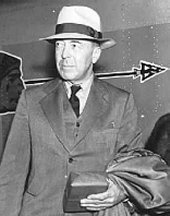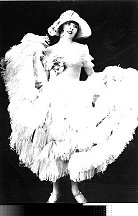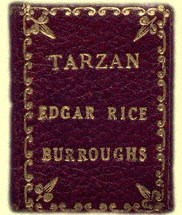
Official Edgar Rice Burroughs Tribute and Weekly Webzine Site
Since 1996 ~ Over 10,000 Web Pages in Archive
Presents
Volume 1477

 |
Edgar Rice Burroughs And Samuel Hopkins Adams A Review Of Warner Fabian's "Flaming Youth" As It Pertained To Edgar Rice Burroughs by R.E. Prindle |
 |
|
Warner Fabian (Samuel Hopkins Adams) Flaming Youth 1923 ERB Personal Library Shelf: A1 ERB Personal Library Shelf: F1 F. Gwynplaine MacIntyre's Review of the movie Flaming Youth 2002
R.E. Prindle Tales Of Space And Time #2 & 3
|
As the 1920s dawned ERB was becoming increasingly restless in his marriage. That he wished out and was looking around is evidenced by 1918's Tarzan The Untamed in which he had Jane murdered and burnt beyond recognition, identifiable only by her jewelry. Late in the novel he has Tarzan eyeing another woman. Perhaps his constant moving contained a notion of losing Emma.
While societal changes had been stirring for a few decades it seemed that they all matured under cover of the Great War emerging like a phoenix in its aftermath. Most importantly sexual attitudes had changed most dramatically. Representative of the changes was the appearance of the flapper. Thought of as a devil-may-care anything goes girl they were enough to excite any man in his mid-life crisis.In 1920, ERB at forty-five would have been in the midst of his. Life was passing while he was evidently in an unsatisfactory marriage. Perhaps it had been unsatisfactory since 1903-04 when he had committed the faux pas which shattered his wife's confidence in him. He was never to regain it during their marriage.
While in this state of mind a book was published followed by its movie which lustfully inflamed his imagination. In 1923 Samuel Hopkins Adams, using the pseudonym Warner Fabian, published his very successful Flaming Youth. While the book doesn't show up on the best seller lists of either 1923 or 24, from January to June it had gone through nine printings of which my copy is of the ninth, for the year perhaps fifteen or more. Still couldn't reach the top ten of the charts, must have been a great literary year. Before the year was out the movie had been made and was in the theatres.
ERB both had a copy of the book in his library and had seen the movie at least once possibly, even probably, several times. If his search for a hot number had been latent before it certainly flamed after. In 1927 he found his flapper ideal in Florence Gilbert Dearholt.
While Flaming Youth was a major success in 1923-24 reading it today makes understanding why difficult. It is not a particularly good book nor really very well written. Adams appears to have dashed it off taking no pains with it. Thus rather than being a literary novel it is more of a pulp romance of the type Bernarr Macfadden would make famous in pulp magazines like True Romance.
Samuel Hopkins Adams had an interesting career. Four years older than ERB he lived eight years longer. He began his career as a journalist writing several articles in 1906 about the patent medicine business which were instrumental in the passage of the Pure Food and Drug Act of that year. The articles were later issued in book form as The Great American Fraud. Burroughs' own life would be seriously affected by the Pure Food and Drug Act through his relationship with Dr. Stace. It was perhaps then he learned about the police and Grand Juries of which he wrote so eloquently.
Adams' career prospered as he was very proficient in writing for the movies. In Flaming Youth he had a doublebarreled hit.
While his title Flaming Youth has entered the vocabulary even as modern youth attempt to 'flame' I found the title somewhat misleading and far better than the story.
Perhaps Adams proves the adage of H.L. Mencken who flourished at this time when he said 'No one ever went broke underestimating the intelligence of the American public.' Actually the story reminded me a great deal of Grace Metalious' 1954 novel Peyton Place. Adams book was definitely aimed at the erotic zone of America.
In a rather clever framing device worthy of ERB's best efforts Adams palms Warner Fabian off as a family physician. I'll quote the frame in its entirety.
Whether ERB got sucked in by such persiflage is open to question. A writer using such flim-flam himself he certainly should have seen through it. Having been a victim of Samuel Hopkins Adams once when the Pure Food and Drug Act drove he and Stace out of the patent medicine business it is kind of a joke that Adams got him a second time with such drivel under the pseudonym of Dr. Warner Fabian. It is mind-boggling that Adams did it posing as a medical quack.A WORD FROM THE WRITER TO THE READER
"Those who know will not tell; those who tell do not know."The old saying applies to woman in today's literature. Women writers when they write of women, evade and conceal and palliate. Ancestral reticences, sexual loyalties, dissuade the pen.
Men writers when they write of women do so without comprehension. Men understand women only as men choose to have them, with one exception, the family physician. He knows. He sees through the body and soul. But he may not tell what he sees. Professional honour binds him. Only through the unaccustomed medium of fiction and out of the vatic incense-cloud of pseudonymity may he speak the truth. Being a physician, I must conceal my identity, and not less securely the identity of those whom I picture.
There is no such suburb as Dorrisdale . . . and there are a score of Dorrisdales. There is no such family as the Fentrisses . . . and there are a thousand Fentriss families. For the delineation which I have striven to present, honestly and unreservedly, of the twentieth century woman of the luxury-class I beg only the indulgence permissible to the neophyte's pen. I have no other apologia to offer.
To the woman of the period thus set forth, restless, seductive, greedy, discontented, craving sensation, unrestrained, a little morbid, more than a little selfish, intelligent, uneducated, sybaritic, following blind instincts and perverse fancies, slack of mind as she is trim of body, neurotic and vigorous, a worshipper of tinsel gods at perfumed altars, fit mate for the hurried, reckless and cynical man of the age, predestined mother of - what manner of being?: To her I dedicate this study of herself.
W.F.
Adams must have learned something along snake oil lines by investigating the patent medicine business. His 'Word To The Reader' is certainly a lesson in promising much and delivering little. It appears to be a conscious attempt too. One must ask if the term Writer in his headline is meant to refer to him or his alter ego Warner Fabian. I rather think Fabian as a 'neophyte' would refer to himself as an author while Adams considered himself a professional writer so that Adams may be speaking in his own persona to the reader when he says 'Those who know will not tell...' so that if he does know he won't tell which alerts the perceptive reader to the fact that what he is about to read is a fraud or a put on; '...those who tell do not know.' or alternatively he doesn't know so what your are about to read isn't authentic.
Further along he says that there is one exception to the rule, as why not? there's always an exception to the rule. That one exception is the family physician. He knows. The only problem with that is that Adams is lying - he is neither the Dr. Warner Fabian he purports to be nor is he himself a family physician. This book is a total medical fraud no less than the patent medicine dealers Adams shut down. Adams carries the fraud further using the purple prose he employs throughout the book: '. . . only through the unaccustomed medium of fiction and out of the vatic incense-cloud of pseudonymity may he (the doctor) speak the truth.'
Anybody here know what vatic means? Our old friend Mr. Webster says that it relates to the seer and prophecy. So much for the concept of medical science. I haven't figured out what the phrase 'vatic incense-cloud of pseudonymity' means yet or maybe we weren't supposed to. If anyone knows let me know. However, it sounds not only good but spectacular. Fabian is only pseudonymous, whatever that means, still he must conceal his identity. A careful reader understands the pseudonymous doctor is not really Warner Fabian so one wonders why he stresses the point so.
Adams does tell you that he is not telling the truth as he frankly admits that there is no Dorrisdale but in the metaphoric sense there are twenty of them. Only twenty in the whole US? Or twenty in the immediate vicinity of wherever. Anyway we are to imagine twenty is an infinitude, something like the stars in a clear cold night sky.
Adams tells us these are very decadent times. He doesn't compare them to any former times like pre-war Dorrisdales but the times are definitely more decadent than they ever have been before. There is no actual Fentriss family, closer to the truth, but there are an allegorical thousand Fentriss families in the twenty Dorrisdales. Figure it out, do the math. Twenty goes into a thousand fifty times. There are fifty such families in each of these small Dorrisdales the population of which is what? Two thousand? fifty families times six members is three hundred. As lessers ape greaters we now have twenty totally decadent Dorrisdales. The whole universe as it were. Since all these families are apparently having nude parties by their swimming pools as in the story so where's the news? Who is there to be shocked?
The book went through nine printings in six months so somebody didn't get an invitation to these orgies. I don't know who. Oh well, not everyone can be in the luxury-class. Proto Jet Set. Andy Warhol's Factory. People need orgies for mental health, don't they? Or do they?
Let's just say the vatic incense-cloud must have been the devil weed itself burning which sent Adams off on this flight of fancy that capture the imagination of a nation. Poor old prurient America. Oh Dr. Freud, turn off the sex spigot.
I found the masterful title a misnomer. The title purports to reveal the antics of modern youth but the only Flaming Youth in the story is Patricia Fentriss - she's a fast one but not that fast, she doesn't go all the way.
Adams is good at setting things up then not delivering. Robert Heinlein must have sat at his feet. In perhaps the book's most famous quote on page 13- 13? Adams dips his pen into his purple ink well to write:Ah, indeed!"That's the measure they dance to, the new generation. Doesn't it get into your torpid blood, Bob? Don't you wish you were young again! To be a desperado of twenty? They're all desperadoes, these kids, all of them with any life in their veins; the girls as well as the boys; maybe even more than the boys. Even Connie with her eyes of a vestal. Ah!"
So who's Adams writing this tripe for?
The title may be Flaming Youth but the story is about Sputtering Age. This is a May-September romance. Burroughs was forty-eight in 1923 and Adams was fifty-two. What yearning for a younger woman occur in those ages. Anything to stave off the march of time. Both men had been raised essentially in the nineteenth century; they must have been thoroughly aroused by the short-skirted flapper of the post-war era. What lusts did these girls call forth? Sam may as well have been standing next to ERB at the dance asking: "Doesn't it get into your torpid blood, Ed? Don't you wish you were young again?"
Darn right Ed wished he was young again, but as that wasn't about to happen the next best thing for an oldtimer to do to revive that torpid blood is to get next to one of those young red hot flappers.
That is what Adams does for himself in Flaming Youth. The book is not so much about Flaming Youth as to return to the flame of youth. Adams acquaints Pat Fentriss with a forty-or-so-year-old ultra sophisticate, hyper intelligent man of the world named Cary Scott. Obviously a simulacrum of himself. As Scott carefully explains to Pat, a good looking body may be good enough for 'the First Dreaming' but she will soon tire of that and her mind in 'the Second Dreaming', this is the family physician talking, will require something more stimulating like himself.
The story then actually concerns the trials and tribulations of this romance until it comes to a happy fruition in the end.
ERB as he was entering his Second Dreaming reached out for a hot young firebrand which he found a short three years later in 1927.
That was the book. Hardly a great or even a very good novel but successful enough to cement Adams' reputation.
The movie which was rushed out by year's end was apparently somewhat different from the book. The movie made the career of Colleen Moore with whom ERB was to have contact a decade later when he wrote the miniature book Tarzan Jr. for her miniature library in her doll house.



In researching the movie the consensus was that no copy had survived. Then I read that one reel survived. And then I came across a review on www.imbd.com/title/tt00145045/usercomments by F. Gwynplaine MacIntyre, a London based journalist, who seemed to have seen the movie.I contacted him and he advised me that a print did exist. He advised me by email that: 'I have viewed a partially deteriorated nitrate print of Flaming Youth in Europe, in the private collection of an individual who does not wish to be publicly identified. The partly deteriorated film includes a few frames of a faded image that appears to be a British exhibition certificate.'
As an example of what ERB saw Mr. MacIntyre describes the action:
"Moore plays Pat Fentriss, the spoilt daughter of well-to-do (luxury-class in the book) parents who are the 1920s equivalent of "swingers". Pat's parents are always throwing wild parties, with jazz bands and (illegal) Prohibition booze and orgies. Pat wants to join in on the fun, even though she's just barely at the age of sexual consent. One young man at the parent's pool party shows a sexual interest in Pat until he finds out her age, then he curtly tells her: 'Baby must go back to her cradle.'That part more or less follows the book. The movie apparently doesn't concentrate on the May-September romance between Cary Scott and Pat. The nudity would be enough to get one's torpid blood flowing like Niagara."The high point of the movie is a scene at the pool party which shows the male and female party guests undressing together for the nude swimming. The film makers probably wanted to show the guests in full nudity, but didn't dare. so we get a lot of indirect lighting and camera angles, with everybody dressing in half-shadow."
According to Mr. MacIntyre in the movie Pat runs away with a fiddler, hopping a yacht for Europe. When the violinist, to be culturally correct, makes his move young Pat leaps overboard to escape his advances. Pretty flaming, huh? With rare good fortune a sailor passing by fishes her out.
In the book Pat meets a violin player or 'artiste', Leo Stenay. Adams shows his distaste for the Bohemian style by having Pat reject him because she feared he wore dirty socks.
As with most writers of the period Adams shows his respect for the Diversity by including and referring to many different types of the Diversity.
Thus the stimulating part of the movie for a revivifying ERB would have been the nude swimming party. One would think they would have been much easier to find in Hollywood than in the score of Dorrisdales with their fifty families of luxury-class, but not for Ed, even though he had just written The Girl From Hollywood dealing with just such licentiousness.
Combining the movie version with Cary Scott of the book ERB became a lonely hunter until he met Florence Gilbert Dearholt, a married woman, when he discovered the perils of The Second Dreaming.
One wonders what course his life would have taken if there had been no Samuel Hopkins Adams, no Great American Fraud and no Flaming Youth. It is strange indeed that a man we have no reason to believe that he had ever met could have had such a profound effect on his life. First with his articles condemning the patent medicine manufacturers which may have introduced ERB to the police and Grand Juries and secondly with Flaming Youth that undoubtedly completed ERB's dissatisfaction with his marriage.
I wonder if ERB ever gave Samuel Hopkins Adams a second thought.
R. E. Prindle welcomes your comments at:
dugwarbaby@yahoo.com
Visit the Prindle Forum and join in on the discussions.
Differing viewpoints are welcome.
To the Navigation Chart for the
R.E. Prindle Series of Articles

